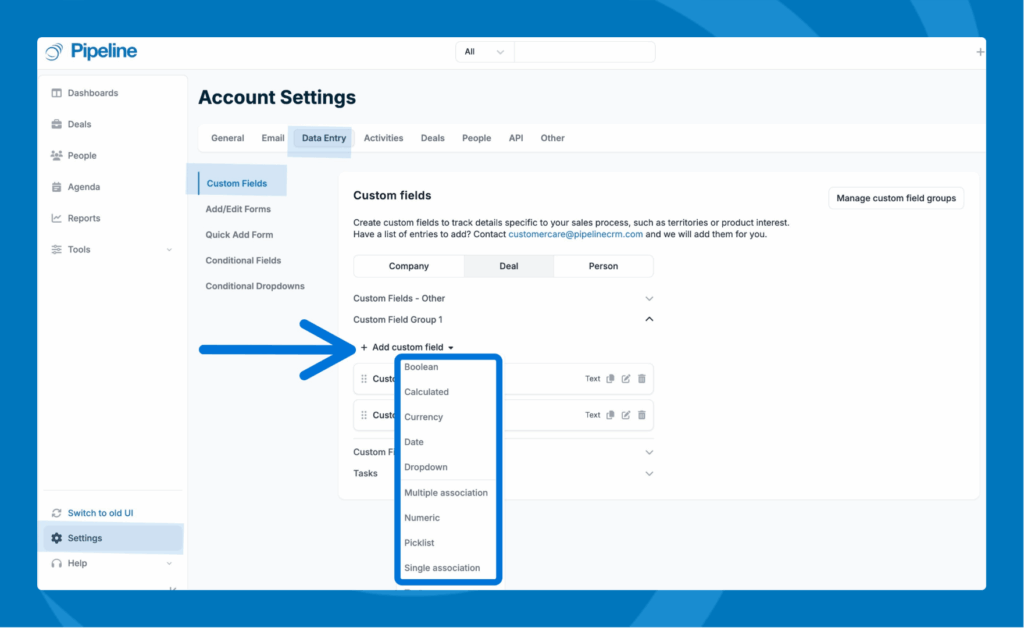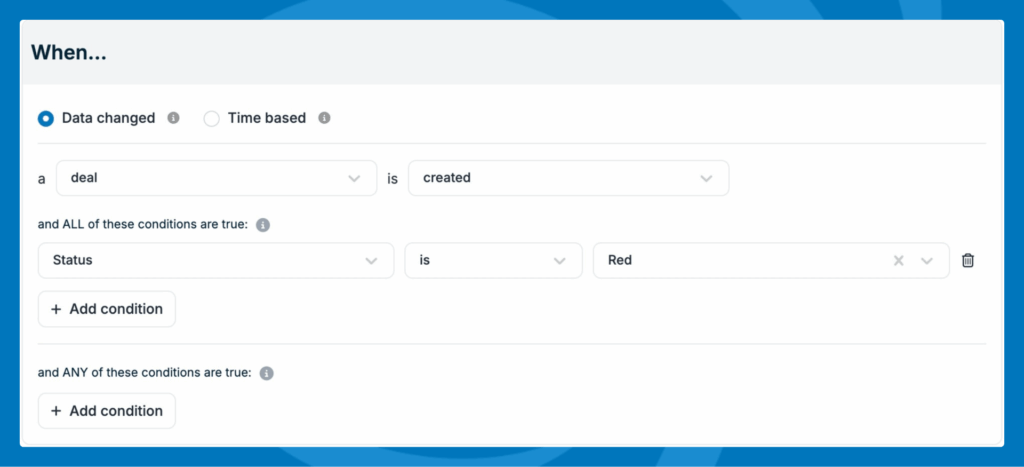If you are asking how to convert leads to sales, the answer starts with building a well-structured sales pipeline. Every lead needs to be captured, tracked, and moved forward quickly to avoid lead decay and lost opportunities. With Pipeline CRM, you can create customizable pipelines that guide prospects through each stage while giving your team the tools to manage tasks, track conversations, and close deals faster.
In this article, we’ll show you how to design a sales pipeline that consistently converts leads with Pipeline CRM, explore the features of our sales CRM software that make it easier to manage your process, and highlight what sales reps really need to win more customers.
Prospect Stages vs. Pipeline Stages for Lead Conversions
In sales, it’s crucial to distinguish between the stages a potential customer (prospect) goes through and the stages of your sales pipeline. Understanding this distinction helps in effectively managing and converting leads.
Prospect Stages
- Lead: This is an unqualified contact who hasn’t confirmed their interest in your business or offer. Qualification is essential – it confirms your contact’s interest and their request for your attention.
- Prospect: These contacts have been vetted, and they’re able and willing to buy your products and services. They’re willing to negotiate with you in good faith, and they’re open to sharing essential details about their circumstances.
- Customer: These contacts have selected you as their provider. They believe you’re the best option to address their desires, goals, fears, or frustrations. They’ve invested their trust in you and paid you for your time and effort.
Sales Pipeline Stages
- Prospecting: These are the steps your team takes to attract, qualify, and disqualify leads. Marketing-qualified leads are contacts who’ve expressed the minimum amount of interest. Sales-qualified leads are contacts who are ready to speak with a sales rep. Sales prospecting is the process of sifting through your leads – giving the qualified a chance to earn their place.
- Info request: The prospect has expressed some interest in your product or service, and they’re interested in converting (e.g., requesting a demo, sign-up for a free trial, and now agrees to schedule a follow-up meeting or phone call for more information. By scheduling a follow-up, the customer shows that they are ready to discuss the next steps and that they view your product as a possible solution to their problem.
- Presentation: Your customer receives information from you regarding your offer. This could be a proposal, quote, pitch deck, sales, or product page. Whatever the format, your pitch provides prospects with your offer and important information they’ll need for their next steps.
- Negotiation: At this stage, there’s a jockeying for position. Prospects and sales reps work their way towards a win/win situation with terms that are favorable to all sides. Negotiation covers pricing, scope, terms, duration, deliverables, and more.
- Decision: The deal is won or lost; your prospect determines whether they’ll continue with your company or pursue alternative options with a competitor. If the deal is won, your prospect changes their identity, becomes a customer, and begins the onboarding process.
Your sales pipeline is a management process, not a funnel. If you’re using a CRM system, your sales pipeline is a visual process that outlines each step in your sales process. Prospects earn their way through your sales pipeline; they take specific actions that move them forward in (or out of) the sales process.
What Do You Need to Convert Your Leads to Sales?
If your prospects are going to earn their way through your sales pipeline, you’ll need an optimized workflow that accommodates their expectations.
What do prospects expect?
- Understanding: you are expected to deeply understand their desires, goals, fears, frustrations, and problems. You should listen to them and possess insights and answers to their complex issues.
- Personalization: research from McKinsey states that 71% of customers demand personalization; 67% are frustrated when they don’t get it. Your customers expect their interactions, your pitch, your solution, and the offers they receive to be customized around their expectations.
- Exceptional service: prospects expect you to treat them as if they’re your only customer. They want you to be available on-demand, eager to serve, and consistently focused on improving their circumstances. Though most customers won’t admit it, they want you to put them first before your other customers and even your personal life.
- Problem-solving: your prospects expect you to figure it out. They will come to you expecting an answer if they encounter a problem. If you can’t provide your prospects with clear solutions to their problems, you’re unlikely to keep them.
- Irresistible offers: these offers are compelling for various reasons; they’re unbalanced (in favor of your prospect), objectively valuable, subjectively appealing, and loaded with risk reversals, guarantees, or warranties. When prospects receive an irresistible offer, they feel it’s too good to be true. Once they get past their initial skepticism, they’re eager to pounce on your offer; it’s too good to pass up.
What Meeting Your Prospects’ Expectations Looks Like in Practice
These seven steps keep active buyers in your sales pipeline. Integrating leads into your sales pipeline is easier if you work to accommodate prospect expectations.
- You actively monitor your CRM system and promptly respond to inquiries and requests from prospects.
- Your team possesses a deep understanding of prospects and their challenges.
- The team is T-shaped, with both extensive problem-solving skills and diverse experience.
- You have gathered valuable insights from marketing, enabling you to offer prospects and customers the personalization they seek.
- You utilize a queue management system that acts as a matchmaker, allowing you to quickly connect customers with sales representatives. This reduces response times and maximizes conversion rates.
- The right offers are presented to prospects at the right moment, tailored to consider each customer’s specific needs.
- Quality assurance frameworks uphold service standards and can be operational, tactical, or strategic. These frameworks ensure your team meets performance benchmarks, leading to increased customer retention, higher conversion rates, and greater sales revenue.
Why is it important to understand and meet your prospect’s expectations?
Since 97% of your prospects are not prepared to buy, engagement is likely to be low. That statistic may seem surprisingly high, but it’s the 3% rule in action.
Only 3% of your prospects are ready to buy at any given moment:
- 7% plan on making a change
- 30% have a need, but they’re not ready to buy
- 30% don’t have a need
- 30% will never buy from your company (even if they have a need)
If you understand your target audience, you will learn their expectations. Knowing their expectations will give you the insights needed to disqualify the 97%. Once you understand this for your business, you’ll know how to convert leads into sales.
How to Convert Leads Using Pipeline CRM’s Customizable Pipeline Management
Now that you understand what it takes to convert leads into prospects, let’s walk through how Pipeline CRM’s sales CRM helps ensure every qualified lead keeps moving toward closing.
Step 1: Set Up Multiple Sales Pipelines
If your team manages different sales processes (e.g., long vs. short deal cycles), multiple stakeholders (e.g., government vs. B2B), or varied territories (e.g., U.S. vs. Europe), you’ll benefit from creating multiple sales pipelines.

With Pipeline CRM, you can build unique deal stages and automation rules for each pipeline, so every sales process is optimized for faster and more predictable lead conversion. See how to configure multiple sales pipelines in Pipeline CRM.
Step 2: Customize Each Deal Stage
Every team has its own way of qualifying leads. Pipeline CRM gives you 12 flexible data fields (text, number, dropdown, date, picklist, etc.) to track the information that matters most for closing deals.

You can also apply conditional formatting and conditional fields to prevent errors and tailor the data you collect. For example, hide or reveal fields based on a prospect’s profile or ensure required details (like budget or decision-maker) are never missed. Explore Pipeline CRM’s custom fields for better sales data management.
Step 3: Create Email Sequence Campaigns
Don’t let prospects go cold while reps juggle other opportunities. With Pipeline CRM’s built-in email campaigns, you can:
- Set up drip sequences with triggers and stoppers
- Save templates for quick reuse
- Track performance to optimize outreach
For added efficiency, pair this with our AI Email Assistant (powered by OpenAI) to craft personalized emails without leaving your CRM or switching tools.

Step 4: Automate Sales Tasks and Workflows
Large sales teams often waste time manually handing off leads between reps. Pipeline CRM eliminates this friction with automated workflows.
For example:
- When a deal moves to Negotiation, Pipeline CRM can automatically reassign it to a senior sales rep.
- If a deal sits in Proposal for seven days, the system can create a follow-up task to keep momentum going.

These automations ensure nothing slips through the cracks and every lead keeps progressing. Learn more about how to set up sales task automation on Pipeline CRM.
See Pipeline CRM sales automation in action through this demo video.
How to Close Leads in Your Sales Pipeline
You’ve identified your active buyers.
You know where you should invest your time, attention, and resources. So, how do you close the active buyers in your sales pipeline?
It’s simple: you read your prospect’s cues, differentiating between education and information.
The Difference Between Educational and Informational Content
Education attracts leads; information converts leads.
Educational content moves customers from the top of your funnel to the bottom. Information works to convert prospects, providing them with the clarity they need to make a purchase decision.
Example: imagine you’re shopping for a hard drive but don’t know much about them. You start searching online, and Google leads you to Newegg’s YouTube channel, where you find an educational video explaining the differences between various hard drives.
This type of educational content is designed to inform and guide potential buyers. It can take many forms—blog posts, whitepapers, research reports, lead magnets, videos, infographics, sales presentations, brochures, and more.
The format isn’t as important as the intent: education. The goal is to help prospects understand a topic, a problem, or a solution.
But education alone isn’t enough to convert a lead into a customer. That’s where informational content comes in.
Informational content builds trust and removes skepticism. It includes things like warranties, guarantees, customer reviews, specs, FAQs, and “About Us” pages—all the details a potential buyer looks for before making a decision.
For example, let’s say Newegg sells Western Digital’s Black Series hard drives. A key concern for any buyer is reliability—how do they know they’re getting a high-quality product? Let’s take a look at their product page.

See the warranty? Western Digital offers a five-year warranty (parts and labor). They’re willing to stand behind their product in a way that most manufacturers don’t. This is the power of informational content—it eliminates doubts and boosts conversions.
The Balance Between Education and Information
Education attracts, while information converts. But there has to be a balance.
- If you push information too soon, you risk coming across as a pushy salesperson focused only on closing the deal.
- If you focus only on education without asking for the sale, prospects may consume endless content without ever converting—what we call education vampires.
It’s not a question of either-or; you need both. The key is knowing when to use each. So, when should you use educational vs. informational content? Let’s break it down.
There are three ways to identify when to use education or information:
- Prospect cues: engaged prospects will provide cues that indicate they are ready to move forward. They may inquire about warranties, contact information, or frequently asked questions—signals that they are seeking more information. When they ask general or education-oriented questions, such as “Which of these products is best for someone like me?”, it indicates they want to learn rather than be sold to at that moment.
- Temperature cues: if you’ve received leads from marketing or a sales manager, you can ask them to assess your prospect’s status. Are they cold, warm, or hot leads? Cold and warm leads typically require educational input, while hot leads are more prepared to receive information. The colder the lead, the more education and relationship-building will be necessary to warm them up.
- Circumstantial cues: keep an eye out for circumstances that may indicate your prospects or customers are about to make a decision. Are there specific holidays, events, or occasions coming up? Did your customer purchase a product that requires specific add-ons? Monitoring circumstantial cues is essential as they generally need educational support to warm up prospects and customers.
This is how you close leads in your pipeline.
Analyze your prospect’s circumstances, read their cues, and offer customers the right content. Your prospects are eager to learn; offer education when they’re looking to you for guidance and share information when they’re looking for reasons to trust.
Convert Leads into Sales With Pipeline CRM
What’s the key to turning leads into sales? An optimized workflow.
As prospects move through your pipeline, their needs and expectations evolve. Understanding these shifts allows you to qualify the right leads, close more deals, and maximize revenue. The best sales teams don’t chase every lead—they focus on the ones that matter.
Join 18,000+ businesses using Pipeline CRM to increase revenue. Pipeline CRM helps businesses like yours close deals faster, increase productivity by 50% or more and boost sales by up to 10x. But don’t take our word for it—see Pipeline in action and discover how it can help you attract, win, and retain more customers.
FAQs About Closing Sales in Your Sales Pipeline
1. How Do You Convert Leads into Sales Effectively?
To convert leads into sales, you need a structured approach that includes prompt follow-ups, lead qualification, and an organized sales pipeline. Research indicates that contacting leads within an hour makes you seven times more likely to qualify them compared to waiting longer. Implementing automation, personalized outreach, and clear value propositions will help nurture leads and guide them toward conversion.
2. How Can a CRM Help Convert Leads?
A CRM system like Pipeline CRM helps you organize and track leads, ensuring that no opportunity falls through the cracks. With features such as automated follow-ups, lead scoring, and real-time insights, you can prioritize your most promising prospects and move them through your sales pipeline more quickly. Businesses using Pipeline CRM have reported a reduction in time-to-close, a 50% increase in productivity, and sales growth of up to 10 times. Try Pipeline CRM to discover how we can help you convert more leads into sales.



